I have been in the house cleaning industry for three decades. We have encountered different types of black bugs during our daily routine. Some tiny black bugs tend to be a nuisance when trying to eliminate them in their dwellings.
Understanding the behavior and characteristics of these tiny black bugs that bite and itch is crucial. This identification guide will help you discover the most common black bugs in your home and tricks for elimination naturally.
Different Types of Black Bugs Found In Homes
Most black bugs love to infest the kitchens, bathrooms, living rooms, and bedrooms. Below is a list of black bugs found in homes with their characteristics for easy identification:
Insidious Flower Bug (Orius insidious)
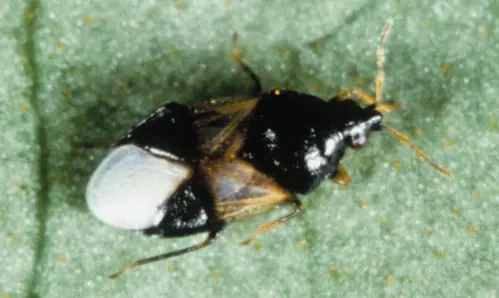
It is a small black bug that measures about 3-4mm long. The dark coloration allows the bug to camouflage the plant leaves in your garden.
The black bug has an oval body with white patches on its wings and distinctive markings on the tails. These features make it easier to identify the black bug from others.
These bugs are native to North America due to the agricultural fields, forests, gardens, and meadows. They are commercially integrated into pest control measures.
Insidious flower bugs feed on aphids, mites, insect eggs, and small caterpillars. They help control the population of agricultural and garden pests to reduce the need for chemical insecticides.
Habitat |
Agricultural fields, gardens, forests, and meadows |
Diet |
Aphids, mites, insect eggs, whiteflies, and small caterpillars. |
Problems |
Damage crops or plants and infest homes |
Identification Features |
White patches on the wings and distinctive markings on the tail. |
Centipedes
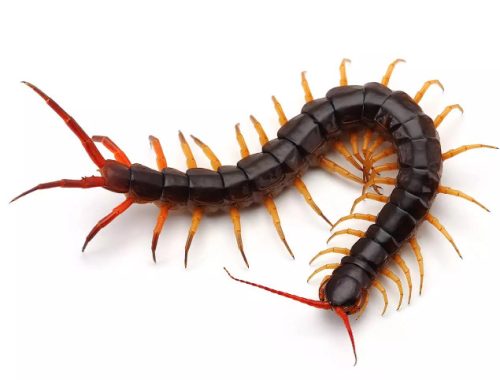
These black bugs have long and flat bodies with numerous segments. The number of segments varies from 15 to 100 since it depends on the species.
Moisture is the main cause of centipedes in homes across North America. These tiny black bugs bite and itch since they have venomous substances.
These carnivorous predators feed on insects, spiders, and other small invertebrates. The venomous substance can subdue the prey with ease and also cause discomfort in humans.
These worm-like crawling creatures measure about 30cm long. Some house centipedes can average up to 100mm long and can cause a nuisance during elimination.
Habitat |
Forests, deserts, grasslands, and urban areas. |
Diet |
Small arthropods, spiders, and insects |
Problems |
Allergies, nuisance indoors, and bites |
Identification Features |
Long and flat body with several segments. |
American Spider Beetle (Mezium americanum)
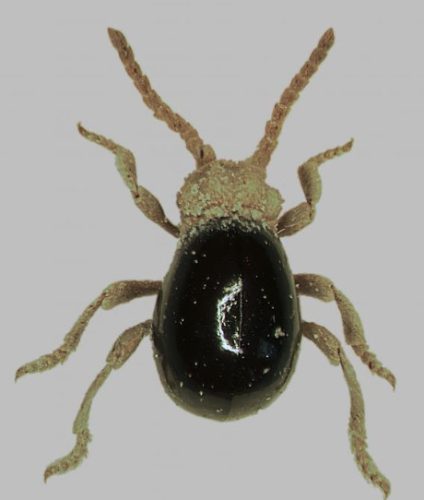
It is a black and orange house beetle that comes out at night only. It has a large and glossy rounded body with an orange to redhead, legs, and antennae.
The ting black bug in the house is also known as the straw-mattress beetle. The velvety small beetle can grow up to 1.5-3.5mm long.
These black spider beetles dwell in damp environments. They can infest the wall cavities, attics, and pantry cupboards. Maintaining good sanitation will help prevent their occurrence in your house.
Habitat |
Dark damp locations |
Diet |
Cereals, fruits, nuts, and pet foods |
Problems |
Damage stored foods |
Identification Features |
Black bulbous abdomen and orange legs, head, and antennae |
Black Widow Spider (Latrodectus)
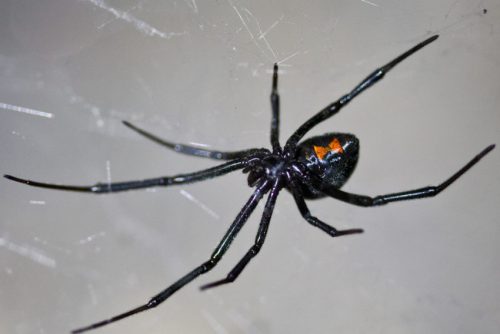
It is the most dangerous black bug in the house. These black bugs have a distinctive red hourglass marking on their bulbous black abdomen. These tiny black bugs can grow up to 1cm long.
A poisonous bite from a black widow spider can cause painful swelling that leads to joint aching, spasms, and muscle cramps. These bugs feed on beetles, grasshoppers, and small flies.
Black widow spiders dwell in dark crevices, pockets, footwear, and behind baseboards. These crawling creatures can bite when provoked.
Habitat |
Dark crevices, pockets, footwear, and behind baseboards. |
Diet |
Beetles flies, and grasshoppers |
Problems |
Painful bites to humans. |
Identification Features |
Brightly colored red marking on the underside of its abdomen |
Oriental Cockroach or Waterbug (Blatta orientalis)
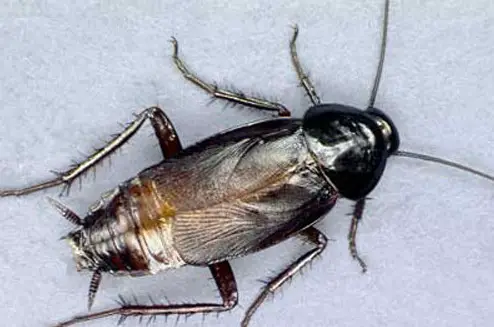
These are medium to large-sized black bugs measuring around 1-1.25 inches in length. They have shiny, dark brown or black bodies and a glossy exoskeleton.
They prefer damp and dark environments since they are also known as Waterbugs. They are commonly found in basements, crawl spaces, drains, sewers, and other areas with high humidity levels.
These black bugs feed on various organic materials like decaying matter, garbage, plant materials, and even other insects. They are a nuisance pest when they infest residential or commercial spaces.
Habitat |
A dark and damp environment |
Diet |
Organic materials |
Problems |
Infest residential or commercial spaces |
Identification Features |
Leathery dark brown to black body, oval shape, and wings. |
Pillbugs (Armadillidiidae)
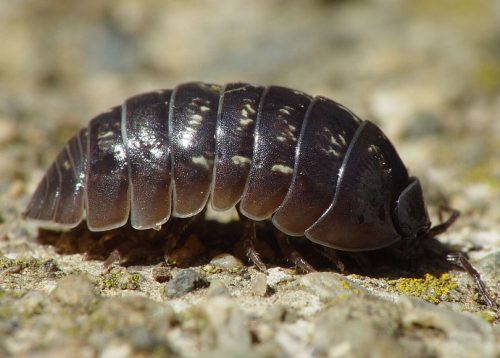
These small black bugs measures between 7 and 14 millimeters in length. They have a dark-brown or grayish-segmented exoskeleton. The oval-shaped body has overlapping plates to allow rolling up into a tight ball.
These bugs thrive in damp and moist habitats since they require a high level of humidity to survive. You can often find them in gardens, leaf litter, under logs, and in other areas with decaying organic matter.
They play a vital role in breaking down dead plant material and returning nutrients to the soil. Their diet primarily consists of decaying organic matter from fallen leaves, rotting wood, and dead plants.
These bugs are harmless and play a beneficial role in ecosystems. They can sometimes become a nuisance in certain situations.
Habitat |
Dark damp location |
Diet |
Decaying matter |
Problems |
Harmless |
Identification Features |
Dark gray or black-colored “bugs” with armor-like bodies |
Black Garden Ant (Lasius niger)
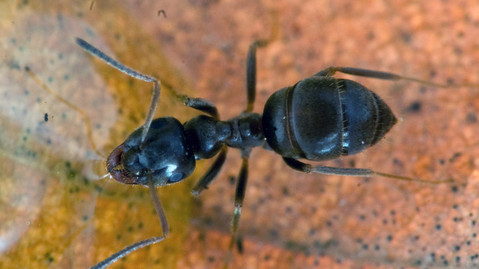
These ants have a characteristic segmented body with a distinct head, thorax, and abdomen. They construct nests in soil, under rocks, or in decaying wood. Their colonies can range in size from a few hundred to several thousand individuals.
Black Garden Ants have a diverse diet. They feed on a variety of food sources, including nectar, honeydew produced by aphids, fruits, seeds, and small insects.
They are generally harmless and play an important role in ecosystems as decomposers and soil aerators. But they can sometimes become problematic when they establish their colonies in close proximity to human activity.
Habitat |
Soil, under rocks, and decaying wood |
Diet |
Sweet foods and sugary substances |
Problems |
Contaminate food |
Identification Features |
Small black bugs having slender bodies with bulbous heads and abdomens |
Black Carpenter Ants (Camponotus)

They are relatively large and have a robust body structure, characterized by a distinct waist and elbowed antennae. Winged reproductive individuals, called alates are larger than males with wings.
They can be found in both natural and human-made environments. They commonly nest in decaying or dead wood, including tree stumps, logs, and wooden structures.
These large black bugs scavenge for sweets such as nectar, honeydew produced by aphids, and sugary substances. They also feed on dead arthropods and the honeydew-excreting insects themselves.
Black Carpenter Ants can weaken the integrity of the wood over time due to nesting. If left untreated, infestations can cause significant problems and require professional intervention for effective eradication.
Habitat |
Decaying or deadwood |
Diet |
Nectar, honeydew produced by aphids, and sugary substances. |
Problems |
Destroy building structures |
Identification Features |
Large, rounded black bodies, long legs, elbowed antennae, and a single segmented node connecting the thorax and abdomen. |
Fungus Gnats
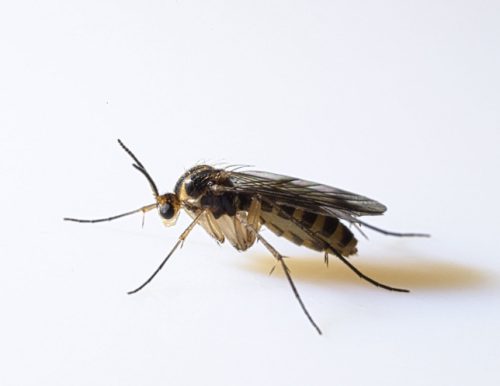
These are small black insects that measure 1.5 to 3.5mm in length. They have delicate, elongated bodies with long legs and narrow wings that are translucent.
These bugs are found in moist and humid environments around indoor houseplants, greenhouses, and gardens. They thrive in areas with damp soil, such as overwatered plants or containers with poor drainage.
The fungus gnats larvae feed on various organic materials, including fungi, algae, decaying plant matter, and roots of potted plants. Adult fungus gnats primarily consume nectar and other sugary substances.
Controlling and preventing fungus gnat infestations typically involves addressing the underlying factors that create a favorable environment for them.
Habitat |
Moist soil |
Diet |
Organic materials and nectar |
Problems |
Damage houseplants |
Identification Features |
Tiny flies that hover over houseplants or moist potting soil. |
Black Weevils
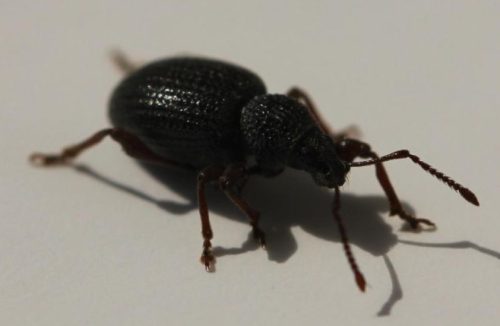
Black weevils measure between 3 to 10 millimeters in length. But their size can vary depending on the species since they have distinctive elongated bodies with a downward-curving snout or rostrum.
They live in forests, fields, gardens, and agricultural areas. They can be found in both temperate and tropical regions, and their distribution is influenced by climate, vegetation, and availability of food sources.
Adult black weevils commonly consume leaves, stems, flowers, and fruits of various plants. Their feeding activities can cause damage to plants leading to reduced crop yields.
Habitat |
Forests, gardens, fields, and agricultural areas |
Diet |
Consume leaves, flower stems, and fruits |
Problems |
Crop damage |
Identification Features |
Oval bodies, small heads, and long, slender snouts. |
Black-Legged Tick (Ixodes scapularis)
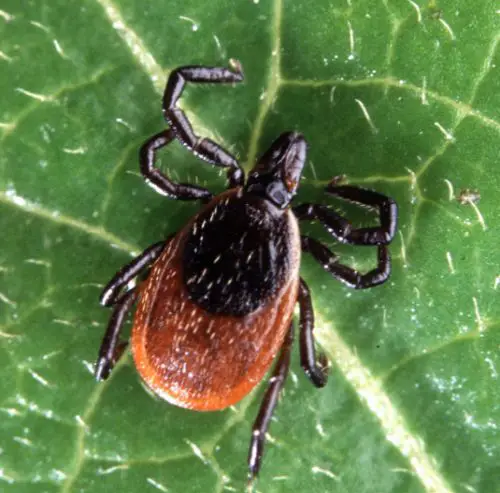
It is a small black arachnid with an oval-shaped and flattened body featuring dark reddish-brown to black coloration. The females are larger in size with dark pigmentation on their legs and upper body.
They are often found in wooded and grassy areas like forests, meadows, and brushy regions. They require a humid environment to survive and thrive.
The Black-Legged Tick is an ectoparasite since it feeds on the blood of various animals to sustain itself. They can transmit diseases due to their feeding activities.
Habitat |
Woodlands and grasslands |
Diet |
Blood from their hosts |
Problems |
Transmission of diseases |
Identification Features |
Tiny black oval body, reddish-brown markings (females), and black legs. |
Fleas (Siphonaptera)
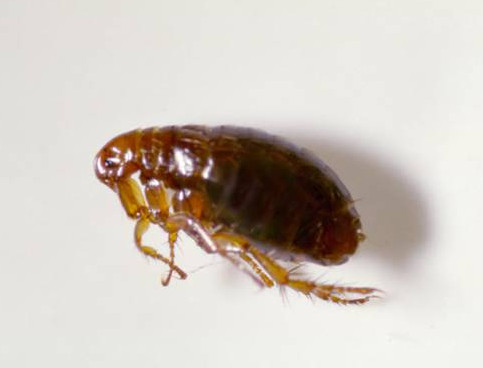
These are quite small black bugs ranging from 1 to 4 millimeters in length. They have a flattened body shape, which enables them to move easily through the fur or feathers of their hosts.
They thrive in warm and humid environments. They can be commonly found in areas with moderate temperatures, such as homes, yards, and animal shelters with organic debris.
They feed on the blood of their hosts. Adult fleas have mouthparts adapted for piercing the skin and sucking blood. They use their sharp, needle-like mouthparts to pierce the skin of their host and extract blood.
Flea infestations can lead to several issues. Pets may experience discomfort, constant itching, and skin allergies due to flea bites.
Maintaining a clean living environment by regularly vacuuming carpets, washing bedding, and treating infested areas can help prevent flea infestations.
Habitat |
Homes, yards, and animal shelters |
Diet |
Blood of their hosts |
Problems |
Bites cause constant itching and skin allergies |
Identification Features |
Tiny black dots |
Black Flea Beetles (Alticini)
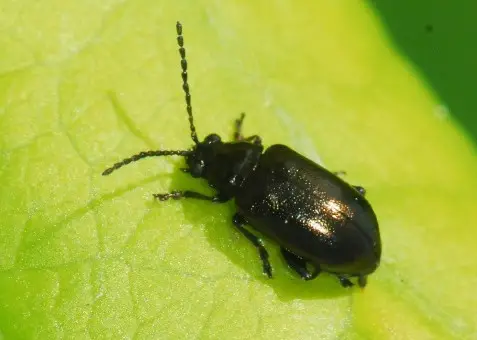
These are small black bugs measuring between 2 to 5 millimeters in length. They have elongated bodies with a compact and robust structure. They have well-developed hind legs to propel themselves quickly and jump.
Black Flea Beetles can be found in a range of habitats, including fields, gardens, forests, and grasslands. They are herbivorous and feed on a wide variety of plants.
Their feeding activity can weaken the plant and, in severe cases, cause stunted growth or death. Controlling Black Flea Beetles often involves integrated pest management strategies.
Habitat |
Gardens, forests, and grasslands |
Diet |
Cabbage, broccoli, radish, and mustard greens |
Problems |
Crop damage |
Identification Features |
Its shiny black oval body and large hind legs it uses for jumping. |
Black Aphids (Aphis fabae)
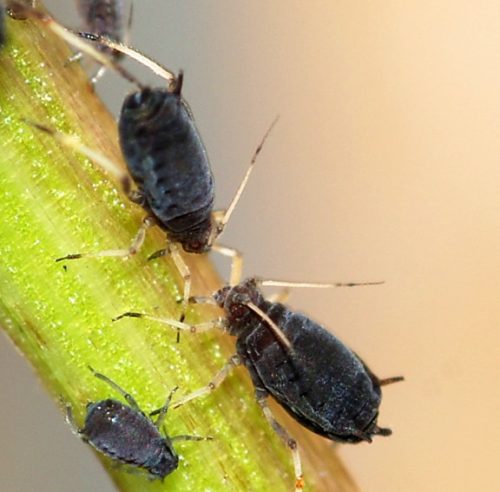
These are tiny black bugs measuring about 1-3 millimeters in length. They have soft bodies and a pear-shaped form with long antennae and tube-like structures called cornicles on their rear end.
Black aphids can be found in various habitats across different regions. They are often seen on the undersides of leaves, stems, and buds of plants.
They feed on the phloem sap of plants. They use their needle-like mouthparts to pierce the plant tissues and extract the sap, which contains essential nutrients for their survival.
The feeding activity of black aphids can cause severe damage to plants, affecting their growth, development, and overall health. Controlling black aphids involves a combination of preventive and management strategies.
Habitat |
Undersides of leaves stems, and buds of plants |
Diet |
Phloem sap of plants |
Problems |
Severe damage to crops |
Identification Features |
Tny bulbous abdomen, long antennae, and black-tipped pale yellow legs. |
Black Carpet Beetle (Attagenus unicolor)
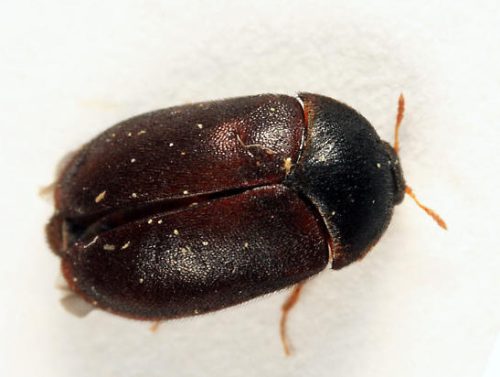
These are small oval-shaped black bugs that measure about 2-5 mm in length. Their bodies are covered in fine hairs. They also have distinct patterns of yellow, white, or brown scales on their wings.
They are prevalent in homes, museums, and other places with stored organic materials. They tend to prefer dark, undisturbed areas such as closets, attics, and basements.
They feed on wool, fur, feathers, silk, leather, and dead insects. They are also attracted to plant-based materials, such as grains, cereals, spices, and dried fruits.
Black Carpet Beetles can cause significant damage to household items and structures. Their larvae are destructive since they have strong mandibles that allow them to chew through fabrics and carpets.
Habitat |
Homes and museums |
Diet |
Wool, fur, feathers, silk, leather, and dead insects |
Problems |
Damage households items and structures |
Identification Features |
Small shiny black body, small clubbed antennae, six legs, and an oval shape. |
People Who Read This Also Read:





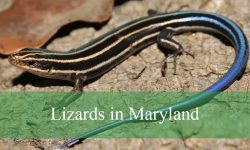

i found this black bug on my counter. It looked like a cross between a black bean and a blackberry it moved very very slow. I saw no antenna or legs